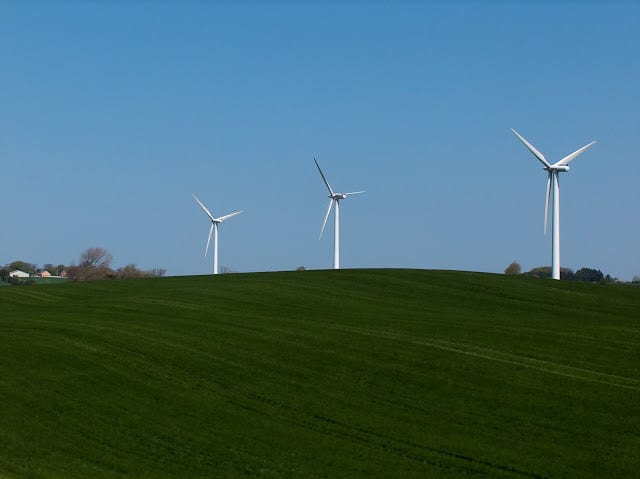On a small island off the coast of Denmark, a group of potato farmers have turned into power brokers, owning the wind turbines that have made their island a net energy producer. In less than ten years, Samsø went from producing 11 tonnes of carbon dioxide per person per year, one of the highest carbon emissions per capita in Europe, to just 4.4 tonnes (the U.S. is at 17.6), and has proven that running on 100 percent renewable electricity is possible.
Denmark is a leader in renewable energy development. In March 2012, the Danish parliament passed a historic new energy agreement to bring the country closer to its target of 100 percent renewable energy by 2050. The agreement set a goal for renewables to provide 35 percent of energy consumption by 2020, and including 50 percent of electricity from wind power. The country is well on its way there—it received more than 30 percent of its electricity from wind in 2012.
Back in 1997, Denmark’s renewable energy ambitions, coupled with an oil supply crisis, prompted the Danish Ministry of Environment and Energy to hold a renewable energy contest. Competing islands had to present a convincing plan for converting their entire energy systems to renewables within ten years, in order to study how high a percentage of renewable energy a well-defined area could achieve with no major grant funding.
All the energy being used on Samsø (population: 4,100) was imported. An engineer thought the island would make a good candidate and submitted a plan. To the island residents’ surprise, Samsø won.
The island now heats 60 percent of its homes with three district heating plants running on straw, and one which runs on a combination of wood chips and solar panels. People outside of the heating plants’ reach have replaced or supplemented their oil burner with solar panels, ground-source heat pumps, or wood pellet boilers. Eleven onshore wind turbines provide 11 megawatts of power, enough to power the entire electrical load of the island (29,000 MWh per year). And 10 offshore wind turbines produce 23 megawatts, enough to compensate for the carbon dioxide emissions generated by the island’s transport sector. This was all accomplished within eight years, two years ahead of schedule.
The most remarkable part about the transformation on Samsø is the involvement of the residents themselves—none of the projects have been imposed by outsiders or funded by major energy companies. Local farmers own 9 of the 11 onshore turbines. The other two are owned by local wind cooperatives. Usually the wind turbine owner/shareholder realizes the initial investment in about eight years, and then starts earning a profit. One of the four district heating plants is also divided into shares and owned by local consumers.
At first, it wasn’t easy convincing this conservative island of farmers that they could, or even should, become a renewable energy showcase. NIMBYism, especially in regards to the proposed wind farm, affected many residents, just as it does in communities around the world. But Soren Hermansen, a local farmer and environmental studies teacher, took up the cause. He spent months going to community meetings and talking up renewables.
The key, according to Hermansen, was to convince Samsingers to participate themselves. “There was a certain fear that the project was just another hippie bureaucracy project sent out by some smart Copenhagen top-down politicians and consultants,” Hermansen told RMI. “My job was to tear these presumptions apart and break it down to daily things that related to everyone in one way or another.” He coined a term “commonity”— a combination of community and commons—which he referred to in his persuasive discussions with the locals to get them on board with the idea of becoming investors in local energy resources.
By owning the turbines themselves, people didn’t feel as if the technology was imposed on them, but that they were making a smart business choice. They also came to realize the benefits that the green development would bring to the island as far as new jobs, new businesses, and increased business from more visitors. The island’s tourism website, Visit Samsø, includes a major section on Samsø as a renewable energy island.
Samsingers now export millions of kilowatt-hours of electricity from renewable sources to the rest of Denmark. The Samsø Energy Academy, opened in 2007, is a source of renewable energy research, education, and training. The academy arranges exhibitions and workshops that attract more than 5,000 politicians, journalists, and students from around the world every year. Researchers from both Danish and foreign educational institutions are able to do energy research at the Academy and island residents can get free advice on sustainable solutions. Furthermore, it functions as a conference center where companies, researchers, and politicians discuss renewable energy, energy savings, and new technologies.
Hermansen has since been named one of TIME magazine’s Heroes of the Environment, and travels around the world telling the story of Samsø’s success. He believes that Samsø’s progress can be a lesson for other places, even though it’s a small rural community. “Scaling can not be done the same way in a city,” Hermansen admits. “But the lesson learned is that it is more about people, communication, and common interest than about technology. When you realize this, it is more easy to see the scalability.”
This article was originally published on the Rocky Mountain Institute’s Outlet blog. Reproduced with permission










